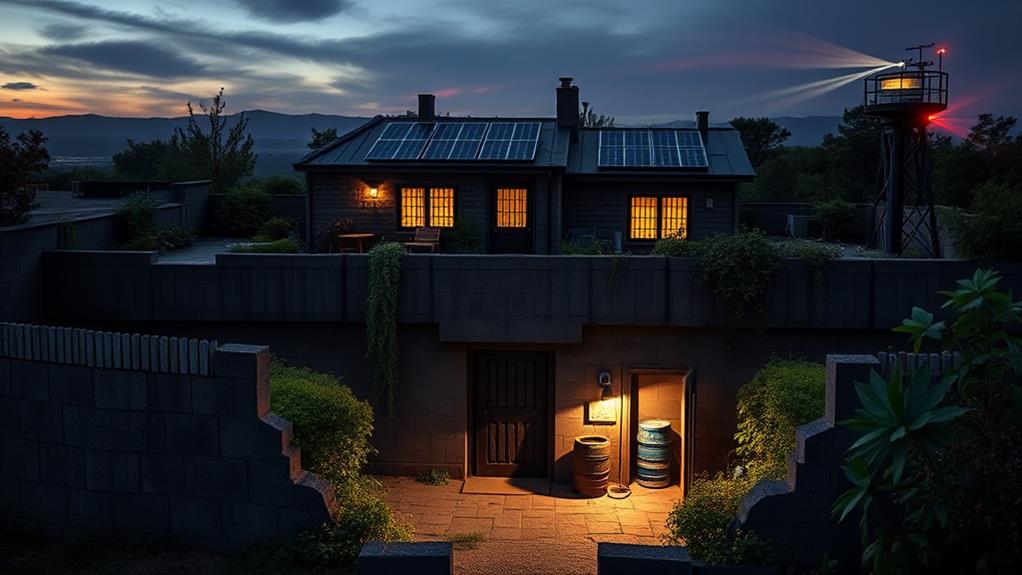
To build a zombie-proof shelter, start by choosing an elevated, isolated location with natural barriers and clear sightlines for early detection. Reinforce entry points with heavy-duty locks and metal bars. Use durable materials like concrete and steel for construction. Plan hidden escape routes with rope ladders or secret tunnels. Stockpile essential supplies, including non-perishable food, medical kits, and tools. Install surveillance systems with high-definition cameras and motion sensors. Safeguard long-term living sustainability with hydroponic gardens and renewable energy sources. By following these tips, you'll create a secure haven and discover additional strategies for ultimate zombie protection. Additionally, consider implementing fast zombie shelter setup steps to ensure quick assembly in case of an immediate threat. This could include pre-assembling modular barricades and storing portable solar panels and water filtration systems for rapid deployment. Regularly practice drills to familiarize everyone with emergency procedures, ensuring preparedness for any scenario.
Choose a Secure Location
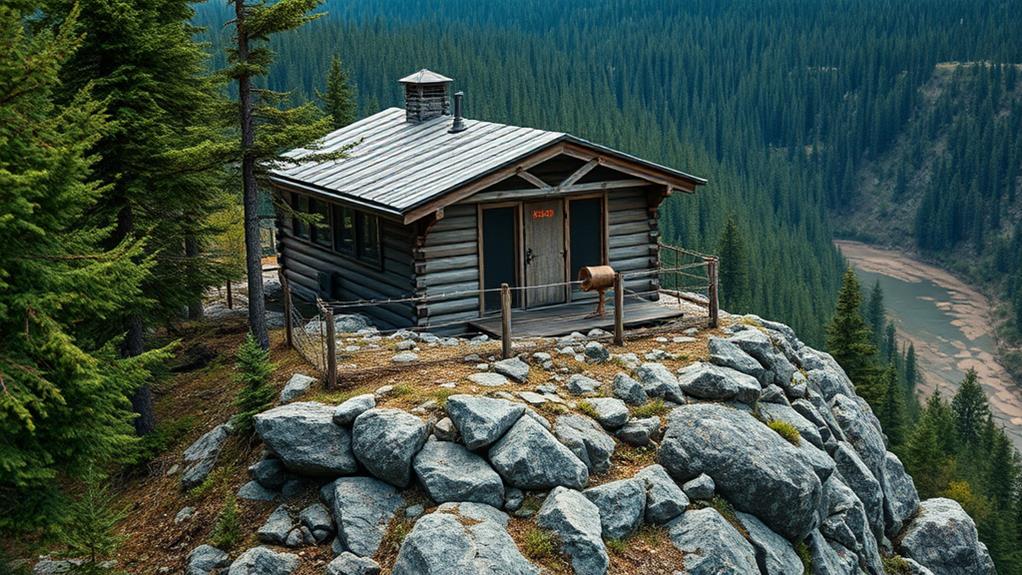
Selecting the right location is essential for building a zombie-proof shelter. First, you need to find an area that's elevated and hard to access. An isolated hill or a building rooftop works well since it reduces the risk of zombies stumbling upon your hideout. Avoid urban centers where the population density increases the likelihood of encountering the undead.
Next, consider the surrounding environment. Look for places with natural barriers like rivers, cliffs, or dense forests. These features can act as a first line of defense, slowing down any approaching threats. Additionally, you'll want to guarantee there's a reliable water source nearby. Without water, your survival chances plummet.
Don't forget visibility. Choose a location with clear sightlines so you can easily spot any approaching zombies. High ground offers an excellent vantage point for early detection. Also, make sure the area is defensible. Natural choke points, like narrow paths or bridges, can make it easier to manage and repel attacks.
Lastly, think about accessibility for you and any group members. While you want to deter zombies, you should be able to enter and exit the location quickly if needed. Balancing isolation and accessibility is key to your safety.
Reinforce Entry Points
Securing your shelter's entry points is crucial for keeping zombies out and ensuring everyone's safety inside. Start by focusing on doors and windows. These are the most vulnerable spots in any structure, so reinforcing them should be your top priority.
Begin with the doors. Install heavy-duty deadbolts and multiple locking mechanisms to make it harder for zombies to break through. You could also add metal bars or grills to both doors and windows for an extra layer of protection. Don't forget about securing the frames as well, as a weak frame can be easily breached.
Windows are another critical area. Consider boarding them up with strong materials, but make sure to leave small openings for visibility and ventilation. If possible, use shatterproof glass to prevent zombies from smashing their way in. Secure any basement windows too, as they're often overlooked but can be an easy access point for the undead.
To paint a clearer picture, here are some specific actions you can take:
- Install heavy-duty deadbolts on all doors.
- Add metal bars or grills to doors and windows.
- Board up windows with strong materials while allowing for visibility.
- Use shatterproof glass for all windows.
Use Durable Materials
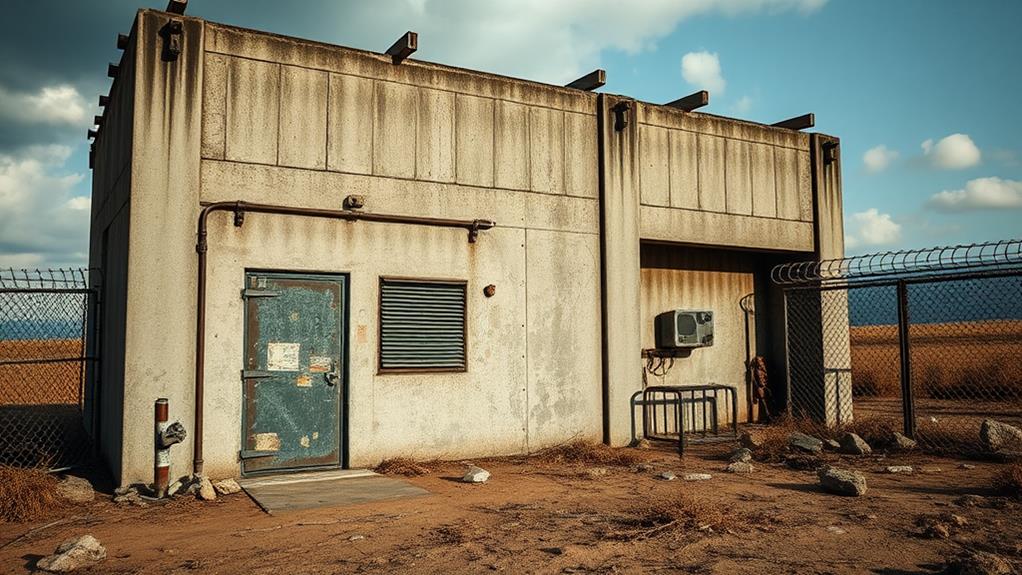
When it comes to building a zombie-proof shelter, using durable materials is non-negotiable. You need strong, resilient materials that can withstand relentless attacks. Concrete and steel are your best friends here. Concrete is tough and can absorb impacts without cracking easily, while steel provides unmatched strength for reinforcing walls and doors.
Next, consider using metal mesh or bars for windows. These additions prevent zombies from breaking the glass and gaining entry. They're also excellent for maintaining visibility outside your shelter without compromising safety. For roofs, opt for metal sheeting or reinforced concrete to avoid any weak points that zombies could exploit.
Don't forget to use quality fasteners and adhesives. Bolts, screws, and industrial-grade adhesives guarantee all your materials stay firmly in place. Avoid nails; they can loosen over time and compromise your structure's integrity.
Also, think about longevity. Pressure-treated wood and corrosion-resistant metals can endure the elements for a long time, reducing the need for frequent repairs. The more durable your materials, the less you'll have to worry about maintenance, allowing you to focus on survival.
Create Escape Routes
An essential part of your zombie-proof shelter is having multiple escape routes. When zombies are on the prowl, you can't afford to be trapped with no way out. Plan these routes meticulously, guaranteeing they're easily accessible and well-hidden from potential threats. Think strategically about how to maximize your chances of survival.
First, consider installing hidden doors that lead to safe zones outside your main shelter. These should be:
- Concealed behind bookshelves or wall panels: Make them hard to detect for anyone who doesn't know they're there.
- Accessible through attic hatches or basement tunnels: Utilize vertical space to your advantage.
Second, create a network of secondary exits at various points around your shelter. These can be:
- Rope ladders or retractable stairs: Quickly deployable and easy to store out of sight.
- Secret underground passages: Leading to a distant location, giving you a head start if you need to flee.
Lastly, guarantee these escape routes are well-maintained and kept clear of obstructions. Regularly practice using them so you're ready when the zombies come knocking. Your life could depend on a swift, unobstructed exit.
Stockpile Essential Supplies
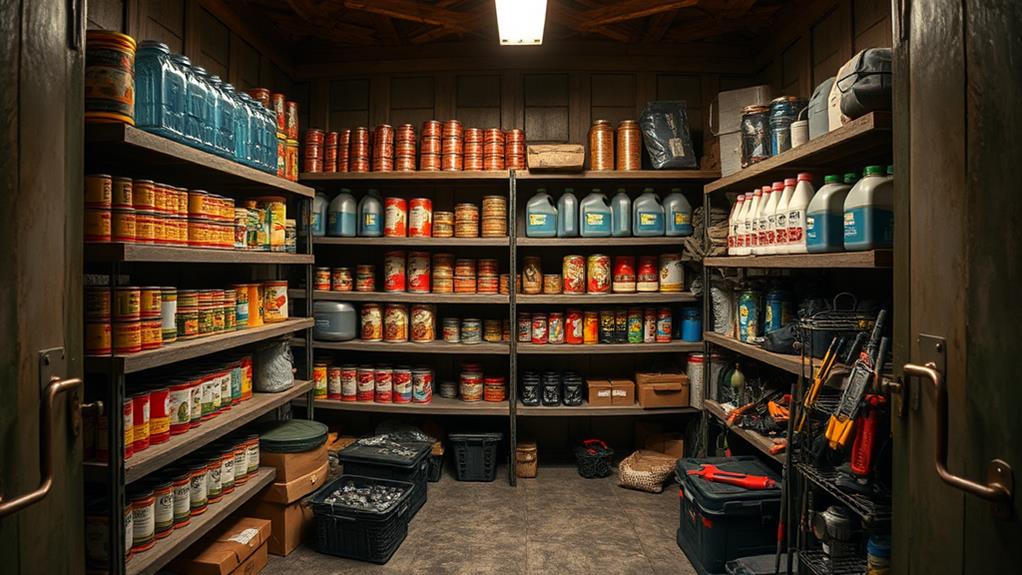
Preparation is the cornerstone of survival in a zombie apocalypse. Ensuring you have essential supplies on hand can mean the difference between life and death. Start by stockpiling non-perishable food items like canned goods, pasta, and rice. These items have long shelf lives and provide necessary calories and nutrients. Don't forget about water—store at least one gallon per person per day for drinking and sanitation.
Medical supplies are vital. Assemble an exhaustive first-aid kit with bandages, antiseptics, pain relievers, and prescription medications. Include items like tweezers, scissors, and a digital thermometer. Personal hygiene products such as soap, toothpaste, and toilet paper will also be important for maintaining health and morale.
You'll need tools and materials for repairs and defense. Keep a stash of items such as duct tape, nails, a hammer, and a multitool. Flashlights with extra batteries, candles, and matches will be necessary for light and starting fires. Don't forget a manual can opener for your canned goods.
Install Surveillance Systems
To keep your shelter secure during a zombie apocalypse, installing surveillance systems is crucial. You'll want to keep an eye on the perimeter to spot any incoming threats before they reach your stronghold. High-quality cameras with night vision capabilities are essential. Place them strategically around your shelter to cover all angles and blind spots.
- High-Definition Cameras: Verify you get cameras with HD resolution for clear visuals, even at night.
- Motion Sensors: Integrate motion sensors with your cameras to trigger alerts when movement is detected. This way, you'll know immediately if zombies are approaching.
- Remote Monitoring: Set up a system that allows you to monitor the camera feeds remotely, whether through a smartphone or a dedicated control room inside your shelter.
- Backup Power Supply: Equip your surveillance system with a reliable backup power source, like solar panels or a generator, to keep it running during power outages.
Plan for Long-Term Living
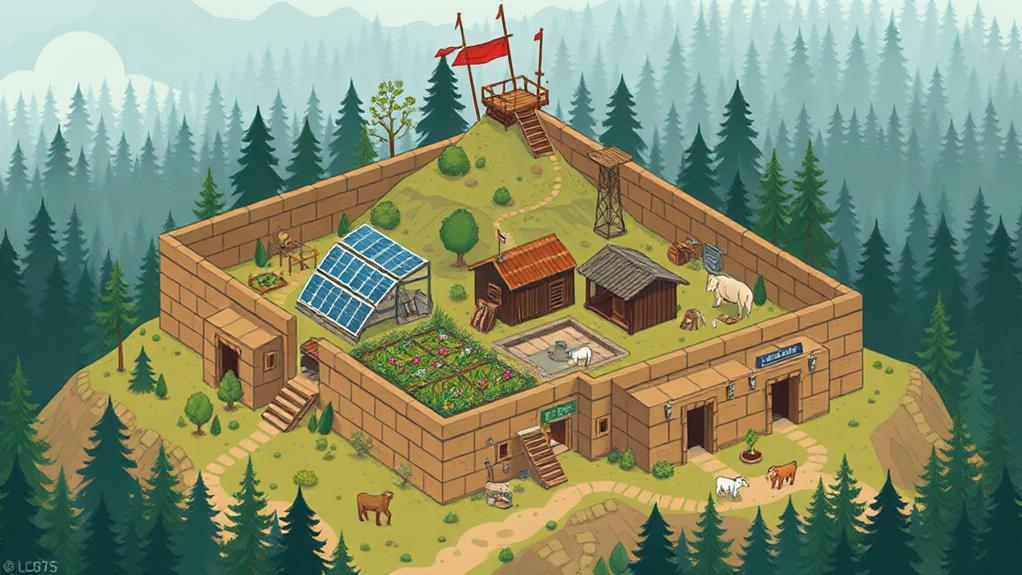
While surveillance systems keep you aware of immediate threats, it's equally important to plan for long-term living in your shelter. Start by guaranteeing you have a sustainable food and water supply. Stockpile non-perishable food items and consider hydroponic gardening for fresh produce. Rainwater collection systems and water filtration units will guarantee a continuous supply of potable water.
Next, think about energy. Solar panels are a reliable, renewable energy source that can keep your essential systems running. Complement them with wind turbines if your location permits. Battery storage will allow you to store excess energy for overcast days.
Comfort and mental health are essential for long-term survival. Designate areas for sleep, work, and recreation. Having a well-organized, multifunctional space can greatly boost morale. Include books, games, and other forms of entertainment to keep spirits high.
Don't forget about medical supplies. Stock up on first aid kits, prescription medications, and basic medical instruments. Learning basic first aid and emergency medical procedures can be lifesaving.
At a Glance
You've got the blueprint for survival now—it's time to act. Remember, a secure shelter isn't just a hideout; it's your fortress against the apocalypse. Choose your location wisely, fortify those entry points, and don't skimp on durable materials. Stock up on supplies, set up surveillance, and plan your escape routes. Long-term living in a zombie world demands preparation and vigilance. Your safety depends on it—so build smart, stay sharp, and you'll outlast the undead.






